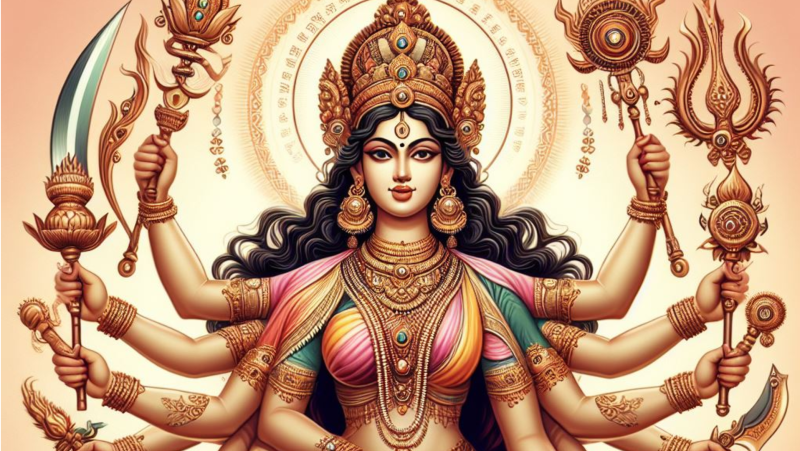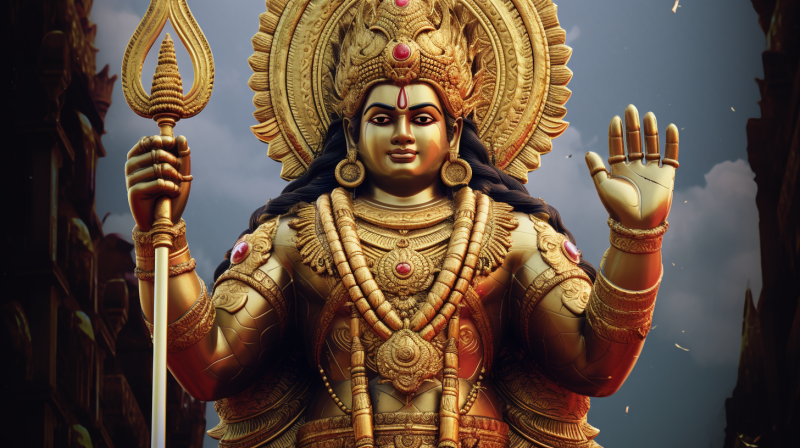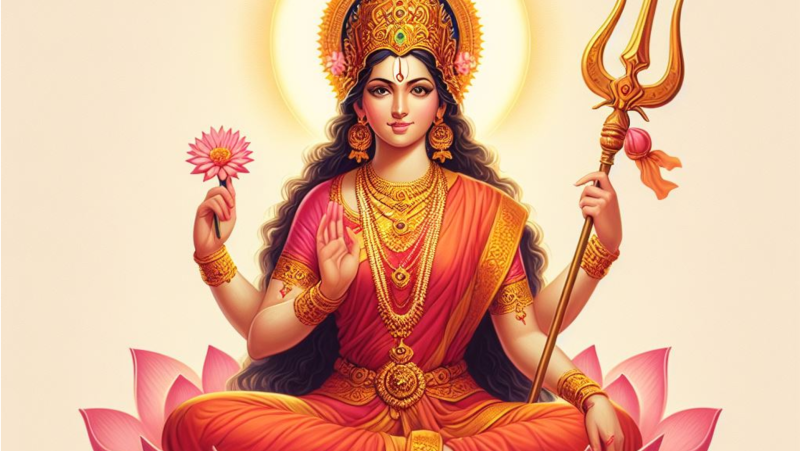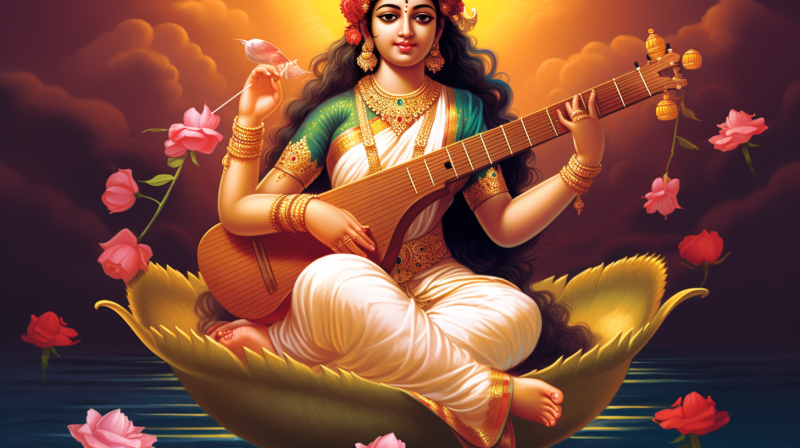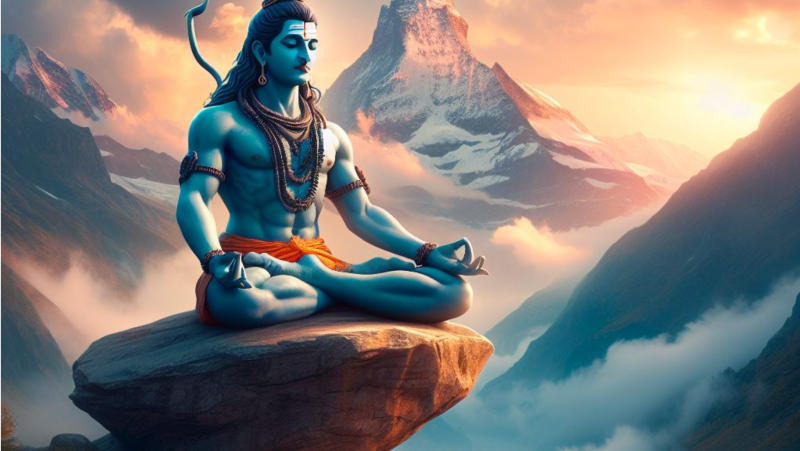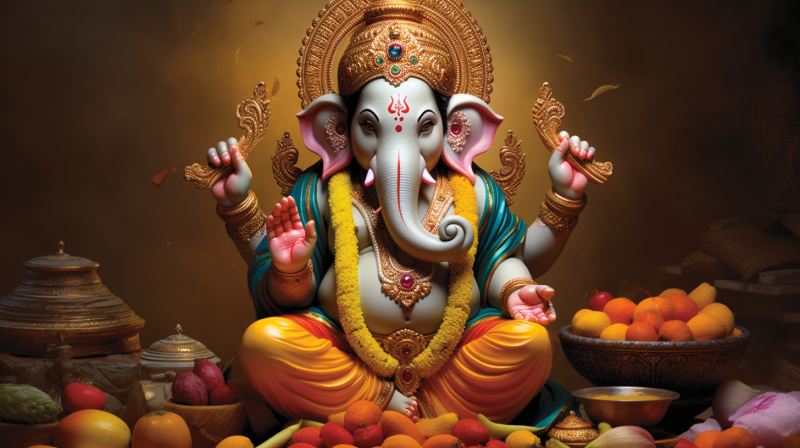
Lord Ganesha, also known as Ganapati, Vinayaka, or simply Ganesha,
is one of the most beloved and widely worshiped deities in Hinduism. He
is easily recognizable by his elephant-headed appearance and is
considered the remover of obstacles, the patron of arts and sciences,
and the deva of intellect and wisdom. Here's a comprehensive overview of
Lord Ganesha:
Lord Ganesha Iconography
Ganesha is typically
depicted as a plump, elephant-headed figure with a human body. He has
four arms, each holding different symbolic items, and is often seated on
a lotus or a mouse. His elephant head is said to symbolize wisdom,
intelligence, and memory.
Birth of Lord Ganesha
The
story of Ganesha's birth is a well-known tale in Hindu mythology. It's
often recounted in the Puranas (ancient Indian scriptures) and various
epics. The most popular version comes from the Shiva Purana and the
Skanda Purana:
Goddess Parvati, the consort of Lord Shiva,
wanted to create a son who would guard and protect her while she bathed.
Finding herself without any assistance, she shaped a figure out of clay
and infused it with her divine energy. She breathed life into the clay
figure and gave it the form of a young boy.
Parvati named her
creation Ganesha and placed him at the entrance to her bath, instructing
him to guard the entrance and allow no one to enter. Soon after, Lord Shiva returned from his meditation and tried to enter the bathing
chamber. However, Ganesha, not recognizing Shiva, refused to let him in.
A
conflict ensued between Ganesha and Shiva, resulting in a battle.
Shiva, unaware of Ganesha's divine origins, became angered and
ultimately beheaded Ganesha. Parvati, upon witnessing this, was
distraught and revealed Ganesha's true identity to Shiva.
Realizing
his mistake, Shiva sought a solution. He instructed his followers
(Ganas) to find the head of the first living being they came across and
bring it to him. They found an elephant and brought back its head. Shiva
attached the elephant's head to Ganesha's body, restoring him to life.
Ganesha was thus reborn with the iconic elephant-headed appearance.
The
story of Ganesha's birth and his family dynamics reflect deep spiritual
truths, such as the cyclical nature of life and the importance of
recognizing the divine in all aspects of existence. It also underscores
the idea that obstacles and challenges are an inherent part of life, and
overcoming them requires wisdom, devotion, and understanding.
Family of Lord Ganesha
• Parents: Lord
Ganesha is the son of Lord Shiva and Goddess Parvati. Shiva symbolizes
destruction and transformation, while Parvati represents fertility,
love, and devotion.
• Siblings: Ganesha has a younger
brother named Lord Kartikeya (also known as Skanda or Murugan).
Kartikeya is considered the god of war and valor and is often depicted
riding a peacock.
• Symbolism of the Family:
-
The divine family of Shiva, Parvati, Ganesha, and Kartikeya represents
various aspects of life and spirituality. Shiva's asceticism complements
Parvati's nurturing nature, and Ganesha's wisdom harmonizes with
Kartikeya's courage.
- Ganesha's close bond with his family highlights the importance of unity, balance, and mutual respect.
Lord Ganesha Symbolism
Ganesha is often associated with the removal of obstacles and
challenges, making him the patron of new beginnings, endeavors, and
journeys. The symbolism of Lord Ganesha is rich and profound,
encompassing a wide range of attributes and teachings. Each aspect of
his appearance and the objects he carries holds deep symbolic meaning.
Here's an explanation of the symbolism of Lord Ganesha:
A. Elephant Head:
The elephant head is perhaps the most distinctive feature of Ganesha.
It symbolizes wisdom, intelligence, and discrimination. Elephants are
known for their strong memory, and Ganesha's elephant head is a reminder
of the importance of retaining and using knowledge to overcome life's
challenges.
B. Large Ears: Ganesha's large ears signify
his ability to listen attentively to the prayers and concerns of
devotees. They also represent the importance of being a good listener,
which is essential for acquiring knowledge and understanding.
C. Small Eyes: Ganesha's
small eyes represent concentration and focus. They signify the ability
to look beyond the outer appearances of things and perceive the inner
truths. This symbolizes the importance of inner vision and insight.
D. Trunk:
Ganesha's trunk is a versatile tool that can uproot obstacles and also
hold blessings. It represents adaptability, flexibility, and
resourcefulness. The different positions of Ganesha's trunk in artwork
carry specific symbolic meanings.
• Curved to the Left: This is the most common position and represents the moon, tranquility, and calmness.
• Curved to the Right: This position is associated with the sun and symbolizes more dynamic qualities.
E. Tusk: Ganesha
is often depicted with a broken tusk. According to mythology, he broke
his tusk to use it as a writing instrument while transcribing the
Mahabharata for Sage Vyasa. The broken tusk symbolizes sacrifice and the
willingness to give up something valuable for a greater cause.
F. Four Arms:
Ganesha's four arms represent his omnipresence and his ability to
engage in multiple tasks simultaneously. Each hand holds a different
object with its own significance:
• Upper Right Hand: Often in a gesture of blessing (abhaya mudra), it represents protection and boon-granting.
• Upper Left Hand: Holds a modak (sweet), symbolizing the rewards of spiritual and worldly fulfillment.
•
Lower Right Hand: Holds an ankusha (elephant goad), which is used to
guide and control the mind, symbolizing the need to control desires.
• Lower Left Hand: Holds a noose (pasha), symbolizing the power to capture and control negativity and attachments.
G. Vehicle - Mouse:
Ganesha's mount, the mouse (often depicted as a rat), represents his
ability to overcome obstacles of all sizes. The mouse symbolizes desire
and ego, and Ganesha's mastery over it illustrates his dominion over
these aspects of human nature.
H. Single Tusk vs. Dual Tusk:
Ganesha is most commonly depicted with a single broken tusk. However,
in some depictions, he is shown with two tusks. The two-tusked
representation is rarer and is associated with the deity's more playful
and childlike aspect.
I. Modak (Sweet Dumpling): The
modak is considered Ganesha's favorite food. It represents the sweetness
of spiritual enlightenment and the rewards of a disciplined and sincere
life.
J. Lotus: Ganesha is often shown seated on a
lotus flower. The lotus symbolizes purity, spiritual growth, and the
unfolding of spiritual potential.
In summary, Ganesha's symbolism
encompasses various virtues and lessons that are relevant to both
spiritual and everyday life. His form and attributes offer a guide to
living a balanced, wise, and obstacle-free existence while remaining
deeply connected to the divine.
Lord Ganesha Festivals
There are
several festivals dedicated to Lord Ganesha, the most prominent of
which is Ganesh Chaturthi. These festivals celebrate Ganesha's birth,
his role as the remover of obstacles, and his benevolent presence in
people's lives. Here are some details about the major festivals of Lord
Ganesha:
A. Ganesh Chaturthi: Ganesh Chaturthi, also
known as Vinayaka Chaturthi, is one of the most widely celebrated
festivals in India, particularly in the state of Maharashtra. It marks
the birth anniversary of Lord Ganesha and is observed with great
enthusiasm and devotion.
• Celebration: The festival
usually falls in August or September. Elaborate clay idols of Ganesha
are crafted and installed in homes and public places. The idols are
adorned with decorations and flowers. Devotees offer prayers, perform
aarti (ritual of waving lamps), chant mantras, and make offerings of
sweets, fruits, and other items.
• Duration: The festival
lasts for around ten days. During this period, the idols of Ganesha are
worshiped daily. Cultural events, processions, and community gatherings
are organized to celebrate the occasion.
• Visarjan (Immersion):
On the final day of the festival, the idols are taken in processions
through the streets, accompanied by music and dancing. The immersion
ceremony, known as "visarjan," involves immersing the idols in rivers,
lakes, or the sea. This symbolizes Ganesha's return to his divine abode
and the cycle of life.
B. Magha Ganeshotsav: This
festival is celebrated in the month of Magha (January/February) and is
especially popular in the Indian state of Maharashtra.
• Significance: It is considered a more private and intimate version of Ganesh Chaturthi, often celebrated within families.
C. Ganesha Jayanti: Ganesha
Jayanti, also known as Tilkund Chaturthi or Vinayaka Chavithi, is
celebrated as the birth anniversary of Lord Ganesha. It usually falls on
the fourth day of the Hindu month of Bhadrapada (August/September).
• Observance: Devotees fast, offer prayers, and chant Ganesha mantras on this day to seek his blessings.
D. Sankashti Chaturthi:
Sankashti Chaturthi is observed on the fourth day after the full moon
of each month in the Hindu lunar calendar. It is a day dedicated to
worshiping Ganesha to overcome obstacles and receive blessings.
• Rituals:
Devotees observe fasting until moonrise and break their fast after
sighting the moon. Special prayers, pujas, and offerings are made to
Ganesha.
These festivals highlight the significance of Lord
Ganesha in Hindu culture and provide opportunities for devotees to
express their devotion, seek his blessings, and celebrate his role as
the remover of obstacles and bestower of auspiciousness.
Lord Ganesha Forms and Manifestations
Lord
Ganesha is revered in various forms and manifestations, each
representing a unique aspect of his divine nature and symbolism. These
forms highlight different facets of his character, and devotees may
connect with specific forms based on their needs and preferences. Here
are some notable forms of Lord Ganesha:
A. Siddhi Vinayaka:
Siddhi Vinayaka is often depicted with four arms, holding a noose,
goad, mango, and a broken tusk. This form symbolizes success,
accomplishment, and the granting of wishes. Devotees seek his blessings
for achievement and fulfillment of their goals.
B. Ucchhishta Ganapati:
Ucchhishta Ganapati is shown in a relaxed posture, often sitting with
one leg folded and the other extended. He is depicted enjoying a meal,
particularly a modak (sweet dumpling), with one hand. This form
represents abundance, enjoyment, and the pleasures of life.
C. Heramba Ganapati:
Heramba Ganapati is depicted with five heads and ten arms, seated on a
lotus. This form is considered particularly protective and is invoked to
remove difficulties and obstacles from all directions. He is often
shown holding weapons and gesturing towards the heavens.
D. Ekadanta Ganapati: In
this form, Ganesha has a single tusk and is often depicted riding a
mouse or a lion. His broken tusk is a prominent feature, symbolizing
sacrifice and self-discipline. This form is associated with wisdom and
restraint.
E. Vakratunda Ganapati: Vakratunda Ganapati
is portrayed with a twisted trunk and often depicted dancing. The word
"Vakratunda" translates to "twisting trunk," symbolizing flexibility and
adaptability in overcoming obstacles. This form is also associated with
creativity and artistic expression.
F. Balaganapati: Balaganapati
is depicted as a child, symbolizing innocence and purity. He may be
shown playing with toys or engaging in childlike activities. This form
emphasizes Ganesha's approachability and love for children.
G. Durga Ganapati: In
this form, Ganesha is depicted with multiple arms and is often
accompanied by the goddess Durga. This form signifies his association
with divine feminine energy and his role as a protector.
H. Taruna Ganapati:
Taruna Ganapati is depicted as a youthful and handsome deity. This form
represents youthful vitality, strength, and the vibrant aspects of
life.
I. Nritya Ganapati: Nritya Ganapati is shown in a
dancing posture. This form symbolizes the joy of music, dance, and the
arts. Devotees seek his blessings for artistic inspiration and creative
endeavors.
These are just a few of the many forms and
manifestations of Lord Ganesha. Each form holds its own significance and
resonates with different aspects of human experience and spiritual
aspirations. Devotees may choose to worship Ganesha in a particular form
based on their personal inclinations and needs.
Lord Ganesha Associations
Lord Ganesha is associated with a wide range of attributes, symbols,
and concepts in Hinduism. These associations reflect his multifaceted
nature and the various roles he plays in the lives of devotees. Here are
some of the key associations of Lord Ganesha:
A. Remover of Obstacles:
Perhaps the most well-known association, Ganesha is revered as the
remover of obstacles (Vighnaharta). Devotees pray to him before
beginning new ventures, important tasks, or journeys, seeking his
blessings for a smooth and obstacle-free path.
B. Patron of Wisdom and Learning: Ganesha
is also the deity of intellect, wisdom, and education. He is invoked by
students and scholars to aid in their studies and enhance their
learning abilities. His large head symbolizes his immense wisdom.
C. Lord of Beginnings: Ganesha
is often invoked at the start of any undertaking, whether it's a new
job, a journey, a project, or an event. His presence is believed to
ensure a propitious start and a successful outcome.
D. Lord of Arts and Sciences:
As the patron of arts and sciences, Ganesha is considered a source of
inspiration for creativity and knowledge. Many artists, writers, and
musicians seek his blessings for their artistic endeavors.
E. Symbol of Unity: Ganesha's
form, with the body of a human and the head of an elephant, is a symbol
of the interconnectedness of all beings and the harmony of diverse
elements coming together.
F. Protector of Home and Family:
Ganesha is also revered as the protector of homes and families. His
presence is believed to safeguard households from negative energies and
bring harmony and prosperity.
G. Source of Inner Peace:
Ganesha's serene and calm disposition represents inner peace. His
teachings encourage individuals to find balance and tranquility within
themselves.
H. Lord of Dharma (Righteousness): Ganesha
is associated with the concept of dharma and upholding moral and ethical
values. His guidance is sought to make righteous decisions and lead a
virtuous life.
I. Symbol of Non-Attachment: Ganesha's
broken tusk, which he sacrificed to continue writing the Mahabharata,
represents the idea of non-attachment to material possessions. This
attribute teaches the importance of letting go of attachment and
desires.
J. Embodiment of Joy: Ganesha's cheerful and
playful demeanor symbolizes joy and happiness. Devotees often pray to
him to remove sorrow and bring joy into their lives.
K. Divine Support:
Ganesha is often invoked before worshiping other deities, as he is
believed to clear the way and create a conducive environment for
spiritual practices.
These associations collectively paint a
portrait of Lord Ganesha as a compassionate and approachable deity who
plays a vital role in guiding and supporting devotees through life's
challenges and triumphs.
Lord Ganesha Variations and Symbolic Meanings
Ganesha's imagery can vary across different cultures and
interpretations. For example, he may be shown with multiple arms holding
various objects with symbolic significance. His mount, the mouse,
symbolizes his ability to overcome challenges of all sizes.
In
addition to his spiritual significance, Ganesha's popularity has
extended into art, literature, and popular culture, both within India
and internationally.
Remember that interpretations and practices
might vary among different communities and regions, but the essence of
Ganesha as a symbol of wisdom, remover of obstacles, and benevolent
deity remains consistent across Hindu traditions.
Certainly, let's delve deeper into various aspects of Lord Ganesha, symbolism, stories, and more:
1. Symbolism:
• Modak: The modak, a sweet dumpling, is considered Lord Ganesha's favorite food. It represents the reward of achieving spiritual wisdom.
• Big Belly: Ganesha's
large belly symbolizes his ability to digest both the good and bad
experiences in life, emphasizing the importance of equanimity.
• Axe: One
of Ganesha's lower hands often holds an axe, which is used to symbolize
the cutting of attachments and desires, leading to spiritual
liberation.
• Noose (Pasha): The noose represents the idea of capturing and controlling desires, preventing them from running wild and causing chaos.
• Blessing Mudra: Ganesha's
upper right hand is often depicted in a gesture of blessing,
symbolizing his benevolent nature and the granting of boons to his
devotees.
• Rat (Mouse): The mouse, which serves as
Ganesha's vehicle, represents desire and ego. Ganesha, by riding the
mouse, signifies his mastery over these aspects.
2. Stories and Legends:
• Writing the Mahabharata:
According to one popular legend, the sage Vyasa dictated the
Mahabharata to Ganesha. Ganesha agreed on the condition that Vyasa
wouldn't pause while dictating, giving Vyasa time to compose the verse
mentally before dictating it.
• Ganesha's Broken Tusk: The
story of Ganesha sacrificing his own tusk to continue writing the
Mahabharata emphasizes his commitment to wisdom and knowledge.
• The Moon's Curse: Ganesha's
fondness for sweets led to a humorous incident where, after consuming
too many sweets, his stomach burst open. In an attempt to soothe him,
other gods tied his belly with a snake. This caused the moon to laugh,
invoking Ganesha's ire, and he cursed the moon to disappear on one day
of the month, resulting in the phenomenon of the waxing and waning moon.
3. Forms and Manifestations:
• Siddhi Vinayaka: This form of Ganesha symbolizes success and accomplishment. He is often depicted holding a bouquet of flowers and a noose.
• Ucchhishta Ganapati: Ucchhishta Ganapati is depicted eating his favorite modak, symbolizing enjoyment and fulfillment.
• Heramba:
In this form, Ganesha is depicted with five heads to represent his
protective nature and ability to remove obstacles from all directions.
4. Beyond Hinduism:
Ganesha's
popularity has transcended Hinduism and can be found in various
Buddhist and Jain traditions as well. He is often revered as a deity who
brings luck, fortune, and positive energy.
Remember that Lord
Ganesha's stories and symbolism are vast and diverse, and they have
been interpreted and expanded upon by various religious scholars,
artists, and writers over centuries. This richness is what makes Ganesha
such a captivating and enduring figure in both spiritual and cultural
contexts.
You may also like …
Are You The Proud Hindu?
The Trimurti
Create an account to join us and start taking part in conversations.
SIGNIN